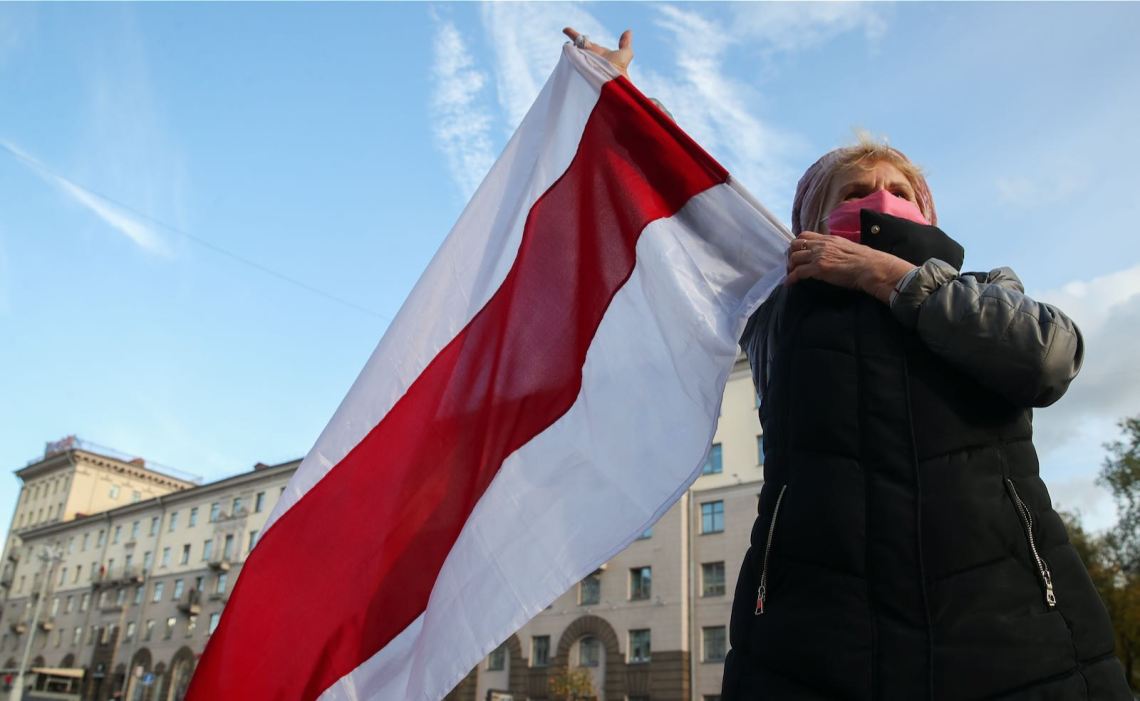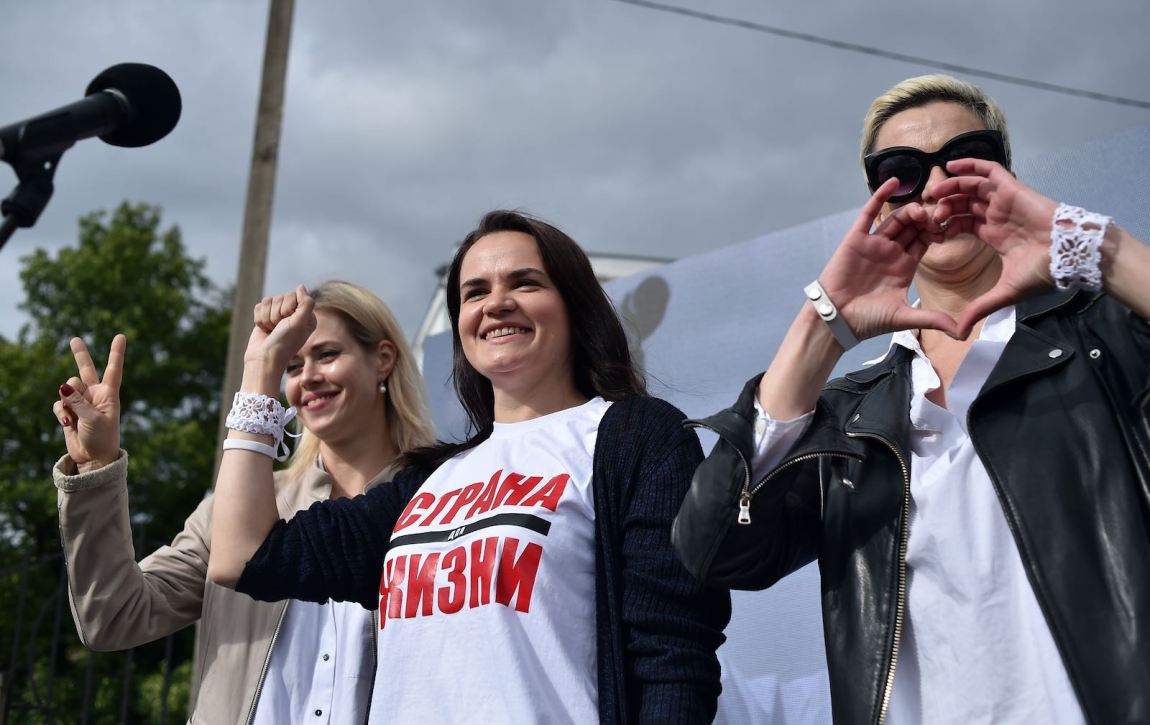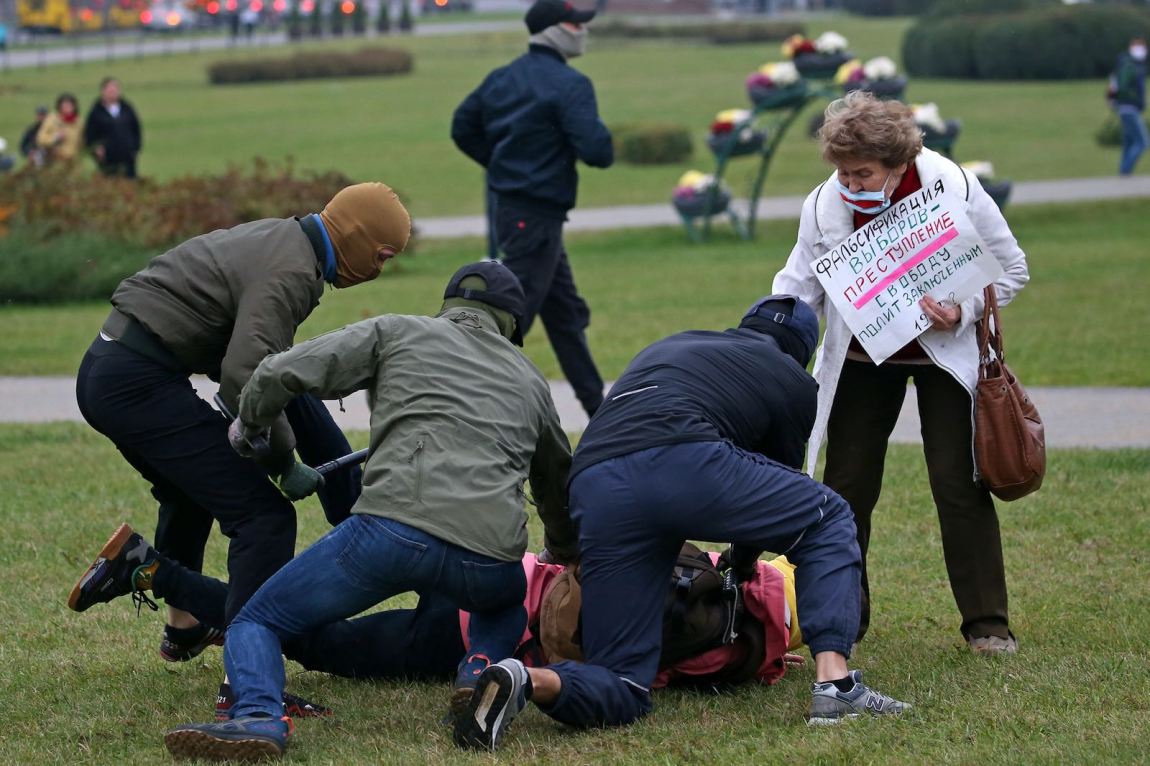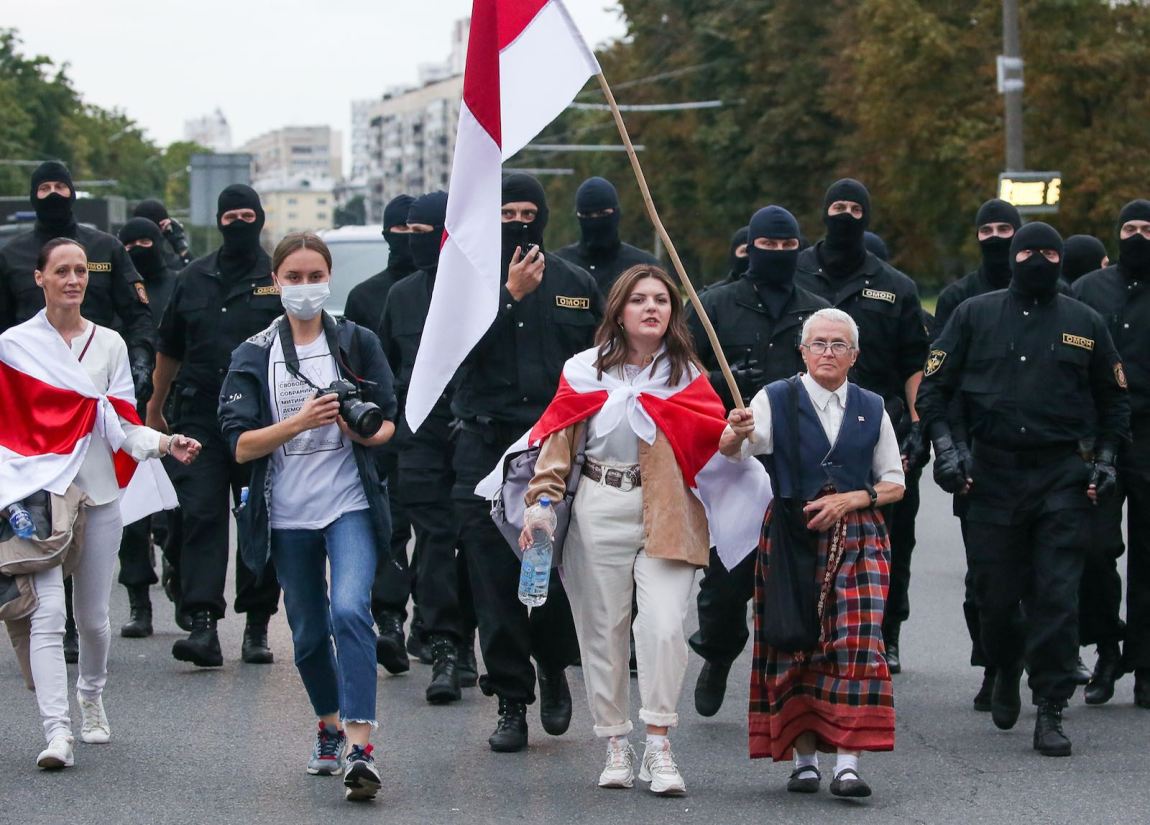On Saturday, thousands of protesters took to the streets in cities across the United States in a reprise of the women’s marches that began on President Donald Trump’s Inauguration Day. The next day, a Norwegian member of parliament nominated three women marchers for the Nobel Peace Prize. But they were not American, they were Belarusian: Svetlana Tsikhanouskaya, Maria Kolesnikova, and Veronika Tsepkalo. They have led an extraordinary social movement that, both before and since the rigged elections that took place in August, has refused to back down in the “struggle for fair elections and for inspiring peaceful opposition against the illegitimate regime in Belarus,” in the words of the citation.
It is hard to do justice, in fact, to their achievement in this country of not quite ten million people that has scarcely had a taste of democracy in its entire history. Landlocked between Poland and Russia, with Latvia and Lithuania to the north, and Ukraine to the south, Belarus was a Soviet republic that did not welcome the collapse of the Soviet Union: in a referendum in 1991, 83 percent of the public voted against independence. And since then, it has had essentially one ruler. Alexander Lukashenko was a former collective farm director who, when he came to power in 1994, promised to restore Soviet-era symbols, including its green-and-red flag, as well as the KGB apparatus of state security. Today, Belarus is the only country in Europe that still has the death penalty—and it is carried out, NKVD-style, with a shot to the back of the head.
The Belarusian protests are still far from achieving all their aims, but they have already made history. At times, countrywide, as much as 5 percent of the population has come out onto the streets for a single day’s demonstrations. And the unity that rapidly developed among various social groups has been remarkable: when workers went on strike in support of the marches, they got backing not only from students and intellectuals, but also from groups that in the past either did not exist or did not have a voice—hackers, for example: pro-democracy renegades from the country’s prosperous IT sector who have also played a vital part in events.
Above all, though, it has been about the leadership and participation of women. Huge rallies organized by Tsikhanouskaya, Kolesnikova, and Tsepkalo were already underway before the August 9 election, but the demonstrations that amazed the world and brought the dictator almost to his knees began that evening in response to the bogus results. For all three, the Nobel nomination brings not just international recognition but a degree of protection as well. During the post-election crackdown, Tsikhanouskaya and Tsepkalo were forcibly banished by the KGB, only to be allowed to return after it became clear that Lukashenko’s initial reflex of violent repression was failing. For her part, Kolesnikova avoided temporary exile by ripping up her passport at the border. Instead, she is in prison, facing five years’ detention.
During Lukashenko’s quarter century and more of dictatorship, he has countenanced no opposition whatsoever, not even a subordinate oligarchy like Russia’s. (As a result, Belarus has surprisingly little corruption; there is only one real oligarch and that is Lukashenko.) Although, until recently, his popular standing meant he could have won reelection by legitimate democratic means, he simply had any serious presidential contender arrested. There had been sporadic protests after one earlier rigged election, in 2010, but for the most part, these involved the fragmentary underground opposition only—and they were quickly suppressed. Support for Lukashenko before this year’s election, however, was sharply lower than in previous years, his approval rating estimated at 15–20 percent.
Lukashenko instructed the electoral commission to report the result of the August 9 election as 80 percent for him, with 10 percent for the united opposition candidate—Svetlana Tsikhanouskaya, “a housewife,” in Lukashenko’s words, who had stood in for her husband, the popular YouTuber Sergei Tikhanovsky, whom the dictator had arrested back in May (according to his standard operating procedure for electoral opponents). Lukashenko could, of course, have chosen to rig the election on a smaller scale—granting himself, say, 55 percent of the popular vote—but, in characteristically psychopathic style, he had to falsify the result grossly, because he could not tolerate even one other politician in his country.
This time, though, Lukashenko made a strategic error. He gravely misjudged the implications of stealing an election after a determined and united opposition had coalesced around a single candidate—one who, in Tsikhanouskaya, symbolically embodied defiance of his antidemocratic schemes. What is happening in Belarus may be the first mass political revolution led from start to finish by women.
*
To a Pole like me, there is also an irresistible analogy with the movement that, exactly forty years ago, changed the course of my country: the independent trade union movement that turned into a popular uprising, Solidarity. But it’s a comparison that Belarusians themselves are fully aware of. One of the anthems adopted by the pro-democracy movement in Belarus is the song “Mury” (Walls) by Jacek Kaczmarski, the songsmith of Solidarity.
Advertisement
The astonishing rise of Solidarity in Poland in 1980 was something that had seemed impossible. Poland then was still thoroughly Sovietized: the Red Army and its nuclear weapons were stationed there, and the country had been a dictatorship subordinated to the USSR since 1944, bordered by similar Warsaw Pact regimes in Czechoslovakia and the German Democratic Republic. Everything was state-owned, there were no independent institutions, and strict censorship was in place. The opposition consisted of several hundred people active in the underground, and though courageous, they occupied a marginal position in society and were regularly thrown into prison for years at a time.
Then, suddenly, following the dismissal of a worker who had been agitating for a free trade union at the Gdańsk Shipyard, a strike broke out, and within months, all of Poland was at a standstill. Ten million people joined the new, independent union, creating arguably the largest organized social movement in the history of Europe, if not the world. Poland dominated the front pages of world newspapers for months. Polish dissidents like Adam Michnik became world-famous. The leader of the movement, Lech Wałęsa, later received the Nobel Peace Prize, and Czesław Miłosz, a poet and leading intellectual of Solidarity, won the Nobel Prize for Literature. This event went down in history as the Polish August.
Now, forty years later, Belarus has its own August. Once again, protests and strikes have broken out in a country that is both dependent on Russia and seen by Russia as within its immediate sphere of influence. And just as in 1980, not only is Western Europe relatively powerless to intervene, but it is also unclear how delighted European leaders are about the prospect of another crisis on their borders—a smoldering conflict like Ukraine’s that could lead to unforeseen geopolitical consequences, unrest and conflict, perhaps a humanitarian emergency leading to a wave of emigration. The United States, though historically more confrontational toward Russia, is distracted and far away, and lacks leverage (trade between the US and Belarus is negligible). Even more than was true for Poles in 1980, Belarusians have only themselves to fall back on.
Despite this weak hand, Belarusians are playing a spectacular game, with a flair and brio that has captivated the world. Like Solidarity, the Belarusian protest movement has been completely peaceful. There have been no broken windows, no rioting, no Molotov cocktails. Belarussians take their shoes off when they stand on a bench. And when it’s time to go home after each protest, they tidy up, leaving not a scrap of trash behind. At a moment when everywhere liberal democracy seems on the point of collapse, a popular movement is resurrecting it—and in a place where there was, essentially, no democratic tradition.
But it’s too soon to declare victory. Psychopathic authoritarians, too, like clean streets—but in a far more sinister way. And when they find themselves cornered, they make bizarre, unpredictable moves. In Lukashenko’s case, as protests erupted after the election, he grabbed a Kalashnikov and, with his teenaged son (he thinks of the dynasty as the only way to feel secure), took to a helicopter to circle over the city. When he saw the scale of these mass demonstrations, visible only from above—on the ground, you see a sea of people stretching out to the horizon—he answered, as always, with indiscriminate violence. The days of terror began.
*
I arrived in Minsk from Warsaw five days before the election. I am not a professional reporter; I am a sociologist and a writer with a penchant for activism, and I was moved to witness the growing groundswell of opposition I was hearing about. I run Krytyka Polityczna, an organization that has supported various civil society initiatives in Ukraine, Russia, Moldova, and Belarus for several years. Partly through my work in this field, I was at the Maidan during the Ukrainian uprising in 2014, so I felt I had to be in Minsk, too.
Often feeling more like a participant than an observer, I wrote reports for the Polish media outlets Onet, Polityka, and our own Krytyka Polityczna (which is the largest left-leaning digital daily in Poland), as well as for Project Syndicate abroad. I gave live reports for Poland’s leading TV news station, TVN24, from both demonstrations and pro-Lukashenko rallies. Working, in effect, as a journalist “without papers,” I was sometimes on the run or in hiding ; but then, at other times, I roamed freely—attending a pro-Lukashenko rally and listening to him bellowing to his bused-in supporters.
Advertisement
On August 9, the day of the election, after the announcement of the preliminary, clearly falsified results, I joined a group marching to gather in protest at the Obelisk, a famous monument in central Minsk dedicated to the resistance to Nazi wartime occupation. There were between one hundred and two hundred thousand people, soon confronted by several thousand security personnel—the so-called siloviki—armed with shields, clubs, tear gas, and flash grenades. Whoever took the large square would win. The opposition demonstrated its strength with numbers and courage, but it faced the full apparatus of state violence. Bit by bit, but inexorably, the security personnel pushed us out, finally chasing and clubbing protesters. One man died after he was deliberately run over by a police truck.
But we learned this rule: the siloviki are brave only when their forces outnumber the protesters, and when they’re armed and wearing balaclavas. Confronted by overwhelming numbers, or when they are not masked, they are afraid to fight.
That night, while I was writing up the day’s events, I witnessed columns of sixty to eighty vehicles filled with riot police and Interior Ministry troops, cars laden with barbed wire, police vans, water cannons, and more. Using this gear, the police arrested some seven thousand people over the next three days. Those detainees were subjected to severe beatings and torture and ended up in notorious prisons like Okrestina and Volodarka. Police detention centers were so overcrowded that prisoners were held in police vehicles parked outside the prisons. The temperature was as high as 90 degrees Fahrenheit; in the eastern city of Gomel, one young detainee died of a heart attack because of excessive heat.
The worst confrontation took place on August 10. Tens of thousands of young Belarusians began to gather around Minsk’s largest metro stations. A barricade was erected by the Riga shopping center. The most dramatic scenes unfolded at Pushkinskaya metro station, where the authorities seized the center of the intersection and deployed hundreds of riot police—ominously, this time, equipped not with shields or clubs, but with rifles with flashlights attached. Access to the intersection was blocked by miles-long lines of cars filled with demonstrators. But the “Lukashists”—as Belarusians call them—had adopted a tactic of assembling at the most important potential sites of protest, such as Pushkinskaya, early in the morning, ahead of the demonstrators.
The previous day, the government’s tactics had still been largely defensive. On August 10, at the metro stations, including Pushkinskaya, we faced off for several hours: demonstrators and soldiers. We thought it would be like the day before: that they would gradually push us out until they took the whole area. But this day, they didn’t have shields, they had rifles. And as in Chekhov’s The Seagull, the rifle would finally fire. And as I was reporting by phone for TVN24, suddenly, without warning, the riot police started to chase us, firing rubber bullets.
We started to run away, dispersing among apartment buildings. Two young women standing by an entryway immediately took me up to their apartment, and it was clear that I would have to stay overnight. Such forms of solidarity and mutual aid have gone on since the beginning of the demonstrations, and they have left me with a powerful impression of the absolute unity that has accompanied the revolutionary atmosphere of the Belarus protests. Especially because I was a journalist, everyone was ready to give me overnight accommodation, or to take me to a striking factory or to a demonstration.
That night, I watched from the young women’s third-floor window and narrated live for TVN24 as groups of soldiers with rifles scoured the neighborhoods, shooting at anyone they saw. Sometimes, the beams from their flashlights raked across the apartment windows. They did not enter the buildings or shoot into them, but many people were injured that day.
How many were kidnapped and killed remains unknown, but according to independent reports, about a hundred people went missing that night; most are still missing, though several bodies have been discovered and there have been reports of hasty burials of corpses in black body bags. One victim was Konstantin Shyshmakov, the twenty-nine-year-old director of the military history museum in Vawkavysk; his body was recovered from a river on August 18. Shyshmakov was one of two members of the electoral commission at a Vawkavysk polling station who had refused to certify the election results.
The two young women had taken in, besides myself, a couple who had also escaped the police rampage. At 4 AM, when the way seemed clear, we snuck out to get a bottle of vodka, collecting a handful of shell casings as souvenirs on the way; when we returned, we drank the vodka, ate herring, and exchanged videos of police violence and injured victims. In the morning, it was clear that the authorities had tried to clean up all traces of the confrontation. With the Internet shut down, I had to wait before sending out my reports and recordings until, by chance, I met an IT specialist who had a private web connection.
Some of the shell casings I’d picked up had been marked, to my shock, “Made in Poland.” When I reported this, it caused a scandal back in Poland. The Ministry of Defense has yet to explain how and why it had armed the Belarusian dictator’s security services; weapons and munitions are supposedly subject to strict export-licensing controls. The terror would last until the next night, August 11. Patrols were sent to the streets, stopping cars randomly, pulling drivers out and beating them. After three days (August 9–11), during which thousands of people were arrested, it seemed doubtful that the protests could continue. On August 12, I had the definite impression that people were scared.
But then, all of a sudden, the next day tens of thousands of women appeared on the streets of Minsk, and in other cities around the country. People started making the V-for-victory sign. Opposition flags appeared again, and the song “Khochu peremen!” (I want changes)—the anthem of the opposition, though originally recorded, ironically enough, by the Soviet rock band Kino—blared from car radios, and drivers honked in solidarity. There was no sound more delightful than this cacophony.
*
When Tsikhanouskaya was exiled to Lithuania after the election, the street protests adopted a new female figurehead: a seventy-three-year-old pensioner named Nina Baginskaya. A veteran of protests in the 1980s against the suppression of information about Chernobyl, she has been at every demonstration this year, without exception. She has racked up so many fines for her protest activity over the years that her house was put up for auction—but no one dared buy it. And her commitment makes everyone else feel a sense of moral obligation to be out there, too.
“Nina” is the Joan of Arc of Belarus’s democracy movement. She always carries the red-and-white flag of the opposition, and the riot police always try to snatch it off her. Murals depicting her tiny, sub-five-foot frame pitted against six-foot-plus riot police have appeared all over Minsk. Nina proves that even if a political revolution in Belarus has not yet been won, a social revolution has taken place.
From August 13, it was the women who took the fight to the regime—right up to the KGB’s front door. Dancing on the steps of the headquarters, they gave courage to the other protesters, while regime officials were dumbfounded, uncertain how to react. Since then, the women marchers have been saving the protests whenever violence threatens. Every Saturday, they go out into the streets and surround the riot police, pulling down their balaclavas and shouting “We are the authorities here!” It is thanks to the Saturday women’s demonstrations that everyone goes out into the streets for the Sunday marches of unity. Even when the dictator sends armored cars and thousands of soldiers into the streets, the Belarusian people are no longer intimidated.
And the women were joined by doctors, who by then had seen hundreds of injured demonstrators on hospital beds. Soon, they in turn were reinforced by workers. The protests of these combined social groups are what the authorities do not know how to handle. Are they supposed to shoot and beat women? Or arrest doctors standing in white coats in front of the hospitals? Should they go into the factories or mines to fight with striking workers? The riot police began to lose their nerve. They knew that to attack women and doctors would provoke an even greater reaction, especially from industrial workers, than their shooting of students on Pushkinskaya did at the outset.
Then, on August 14, the employees of the metro, another important institution in Belarus, came out in sympathy with the protesters. The tide kept flowing. The head of the Orthodox Church addressed the faithful in the streets and apologized for congratulating Lukashenko on his stolen victory. Staff at the state TV station went on strike and joined the demonstrations, carrying banners with slogans such as “We are tired of lying.” For the first time, state television showed footage of protests (the broadcaster only returned to normal operations when Russia sent journalists to replace the Belarusian dissidents).
And another miracle: a detachment of thirty or so soldiers guarding a government building on Independence Square, which would go on to become the site of the largest weekday demonstrations, flung down their riot shields. It seemed as if they were refusing to carry out an order to attack their compatriots. Women went up to the soldiers, hugging them and putting flowers through the buttonholes in their uniforms. People wept.
Throughout the entire protest, including the latest resurgence this week, the regime has reacted to the demonstrations by turning off the Internet. The purpose is to hamper communication between protesters and the social media amplification of the events, but the tactic comes at a high price for the government. Belarus has a very strong IT sector, producing apps like the popular messaging service Viber and games like World of Tanks, and making software companies like PandaDoc into global brands. Tech accounts for about 6 percent of the country’s economy—a much larger proportion than other countries of the region, including even Baltic states with better-known IT industries. The tech sector has unequivocally sided with the opposition.
The regime was particularly horrified by the declaration by the owner of PandaDoc that he would financially support all law enforcement officers who decided to “come over to the people’s side” and leave their jobs. Soon after, he announced on Facebook that he had already received almost six hundred applications from security services personnel who wanted to quit their jobs because of his offer. The authorities swiftly conducted a search of the company’s headquarters and opened an investigation for alleged non-payment of taxes. Protesters reacted by roaming the streets in panda costumes—making the riot police look distinctly foolish, as they chased people in panda suits around the city.
On August 16, Lukashenko tried a new approach, calling for a counterdemonstration in Independence Square, and people were bused in for his rally, many state employees acting under duress. But videos of Lukashenko supporters being taught to shout slogans together and receiving flags and banners on the buses soon leaked and were circulated on social media. And that same evening, the opposition mustered a rally ten times the size.
In an attempt to appeal to his base among manufacturing workers, Lukashenko visited the MKTZ automotive factory on August 17—only to be greeted by a chorus of “Go away!” Badly rattled, he tried to divide the workers by calling out “the small screaming group,” but in the face of their unity, he was forced to give up: “I’ve said everything, you may now continue shouting ‘Go away!’”
*
Besides the regime’s self-inflicted wound of switching off Internet service, a widespread strike has huge costs for the national economy. Belarus has not been hit by the sort of deindustrialization that laid waste to vast swaths of Eastern Europe’s post-Soviet economies. Instead, its large, relatively modern industrial plants turn out trucks, tractors, machinery, weapons, and fertilizers that are exported to the entire world—a source of national pride as well as prosperity. Partly as a result, Belarus has a relatively high standard of living: its GDP per capita is more than double that of Ukraine, and the country has one of the lowest poverty levels in Europe, according to the World Bank.
This is also due in part to Belarus’s historic ability to buy natural resources from Russia at steeply subsidized rates, then process them at its large plants and sell the products to the West at market prices. While the longevity of Lukashenko’s dictatorship may be rooted in nostalgia for the USSR, it owes a great deal to his regime’s Russian-backed economic legitimacy.
Lukashenko was able to provide a generous welfare state at Russia’s expense, but he has tested Moscow’s patience to breaking point with his independence and willingness to walk back the promises he has made to his Russian benefactors. Belarus was supposed to adopt the Russian ruble a long time ago, and the two countries’ legal, political, and economic systems were supposed to be integrated; none of it has happened. Belarusian companies were also supposed to be privatized—with huge concessions to Russian oligarchs or Russian state companies such as Gazprom—but these measures, too, Lukashenko successfully dodged.
Belarus’s independence and its business model under Lukashenko have thus long been a source of antagonism for Vladimir Putin. Radosław Sikorski, who served as Poland’s foreign minister from 2007 to 2015, tells the story of how he once told Russia’s minister of foreign affairs, Sergey Lavrov, that “According to our estimates, Belarus has already cost you $100 billion.” To which Lavrov replied, “If only it were so little!”
Putin did not control the situation in Belarus either before or during the current crisis. After Ukraine, he did not want to risk losing another pro-Russian satellite. If Lukashenko were overthrown, Russia would most likely accept an opposition candidate—provided he or she made no moves to join NATO or the European Union, and pledged to maintain friendly relations with Russia. This scenario has already played out in Moldova, Armenia, and Georgia.
Initially, then, Russia committed neither to backing nor undermining Lukashenko. Only once it saw that a standoff with the protest movement had developed and that he was not in immediate danger of being ousted, did Russia extend him its active support—and start billing him for it. With the economy at a virtual standstill and the value of the Belarusian ruble tumbling, Lukashenko urgently needed cash. The first installment of aid from the Kremlin was $1.5 billion—on which Lukashenko made a rhetorical down payment by rhapsodizing about a common homeland united with Russia. In response, Svetlana Tsikhanouskaya wrote to Putin to tell him that this debt was owed by Lukashenko alone, and not the Belarusian people.
Lukashenko has certainly had to make serious concessions to Putin, agreeing to increase the Russian military presence in Belarus and selling some state-owned enterprises. The Russians, however, can be sure that as soon as Lukashenko gets on his feet, he will try to dodge his obligations once more. But Russia is not willing to defend Lukashenko at any cost, and he is a much-weakened leader.
After the days of terror, Lukashenko realized that he had no support within the country and few options. Not only did he have to turn to Russia, but he also could not afford to outrage his own people with further violent repression. Forty years ago, it was possible for the regime to suppress the Polish protests with martial law and limp along for a few more years, but it turned out that its days were numbered. So it may be with Lukashenko.
For their part, the protesters of Belarus have not overthrown the dictator, but neither did Solidarity oust General Jaruzelski in Poland in 1980. But like the 10 million Poles of Solidarity, Belarusians have discovered their own strength. And they have learned new tactics.
If they cannot gather in Independence Square during the week, they protest in their own streets—organizing neighborhood concerts, hanging flags, displaying symbols of independence. The police are empowered to confiscate such items—but people mock the officers, scrawling “this is not a flag” on pieces of cloth draped from their balconies. Students form flash-mob demonstrations, which the riot police chase away, arresting whom they can—but the young people keep coming back, popping up in another place. And the hackers keep up their harassment, launching cyberattacks on the state. On one occasion, the Ministry of Internal Affairs site was hacked so that Lukashenko appeared on a list of wanted criminals. On the state TV website, the transmission of government propaganda was interrupted by footage showing brutal repression by the authorities.
On September 12, hackers calling themselves cyber-partisans succeeded in obtaining a list of tens of thousands of Ministry of Internal Affairs employees. The hackers announced via Telegram Messenger that they had a week to leave government service or face leaks of their personnel data. When the week was up, and hackers began to carry out their threat, hundreds of panicked officials started quitting.
Lukashenko still has more than 100,000 people on the payroll of his state security system, but he has to pay dearly for their loyalty—especially now, when they are threatened with social ostracism. The ranks of those whose allegiance Lukashenko can rely on is shrinking, and tellingly, his September 23 inauguration went ahead in secret—even though, by law, it should have been broadcast by radio and television. Instead, the airwaves were taken up by Russian sitcoms.
And the joke is on him, as the regime constantly finds itself bamboozled by the women’s movement. A typical example: after receiving reports of an illegal assembly, a riot squad is dispatched to disperse it. But when they get there, it turns out to comprise three elderly ladies sitting on a bench, each holding piece of paper: the first sheet is white, the second red, the third white again—the colors of the pro-democracy movement’s flag. Sheepishly, these masked commandos with no identification numbers herd the women into a car and carry them off to jail.
How many sweet old ladies can a regime lock up without looking ridiculous? Even the strongest leader loses power when he is no longer obeyed. But the terminal stage is when he becomes a laughing stock.







